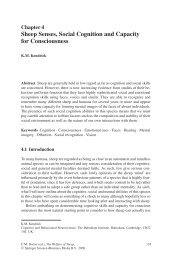Ulric Neisser
Ulric Neisser
Ulric Neisser
Create successful ePaper yourself
Turn your PDF publications into a flip-book with our unique Google optimized e-Paper software.
<strong>Neisser</strong>, U. & Becklen, R. (1975). Selective looking: Attending to visually specified events. Cognitive<br />
Psychology, 7, 480-494.<br />
<strong>Neisser</strong>, U., Boodoo, G., Bouchard, T.J., Boykin, A.W., Brady, N., Ceci, S.J., Halpern, D.F., Loehlin, J.C.,<br />
Perloff, R., Sternberg, R.J., & Urbina, S. (1996). Intelligence: Knowns and unknowns (Report of an APA<br />
task force). American Psychologist, 51, 77-101.<br />
<strong>Neisser</strong>, U. & Harsch, N. (1992). Phantom flashbulbs: False recollections of hearing the news about Challenger.<br />
In E. Winograd and U. <strong>Neisser</strong> (Eds.) Affect and accuracy in recall. New York: Cambridge University Press.<br />
<strong>Neisser</strong>, U. Novick, R., & Lazar, R. (1963). Searching for ten targets simultaneously. Perceptual Motor Skills,<br />
17, 955-961.<br />
<strong>Neisser</strong>, U., Winograd, E., Bergman, E.T., Schreiber, C.A., Palmer, S.E., & Weldon, M.S., (1996). Remembering<br />
the earthquake: Direct experience vs. hearing the news. Memory, 4, 337-357.<br />
Selfridge, O.G., & <strong>Neisser</strong>, U. (Aug 1960). Pattern recognition by machine. Scientific American, 203, 60-68.<br />
Spelke, E., Hirst, W., & <strong>Neisser</strong>, U. (1976). Skills of divided attention. Cognition, 4,215-230.<br />
Usher, J.A. & <strong>Neisser</strong>, U. (1993). Childhood amnesia and the beginnings of memory for four early life<br />
events.Journal of Experimental Psychology: General, 122, 155-165.<br />
Wallach, H., O'Connell, D.N., & <strong>Neisser</strong>, U. (1953). The memory effect of visual perception of threedimensional<br />
form. Journal of Experimental Psychology, 45, 360-368.<br />
Other Publications Cited<br />
Banaji, M.R, & Crowder, R.G. (1989). The bankruptcy of everyday memory. American Psychologist, 44, 1185-<br />
1193.<br />
Broadbent, D.E. (1958). Perception and communication. New York: Pergamon Press.<br />
Fivush, R. (Ed.) (1990). Knowing and remembering in young children. New York: Cambridge University Press.<br />
Gibson, J.J. (1966). The Senses considered as perceptual systems. Boston: Houghton Mifflin.<br />
Hebb, D.O. (1949). The organization of behavior. New York: Wiley.<br />
Herrrnstein, R.J. & Murray, C. (1994). The bell curve: Intelligence and class structure in American life. New<br />
York: Free Press.<br />
Most, S.B., Scholl, B.J., Clifford, E.R. & Simons, D.J. (2005). What you see is what you set: Sustained<br />
inattentional blindness and the capture of awareness. Psychological Review, 112, 217-242.<br />
Rhine, J.B. (1947). The reach of the mind. New York: W. Sloane Associates.<br />
Solomons, L.M. & Stein, G. (1896). Normal motor automatism. Psychological Review, 3, 492-512.<br />
Sperling, G. (1960). The information available in brief visual presentations. Psychological Monographs, 74, No.<br />
11.<br />
Thompson, C.P., & Cowan, T. (1985). A nicer interpretation of a <strong>Neisser</strong> recollection. Cognition, 22, 199-202.<br />
20




